
Barn-owls are one of the two families of owls, the other being the true owls or typical owls, Strigidae. They are medium to large owls with large heads and characteristic heart-shaped faces. They have long, strong legs with powerful talons. They also differ from the Strigidae in structural details relating in particular to the sternum and feet.
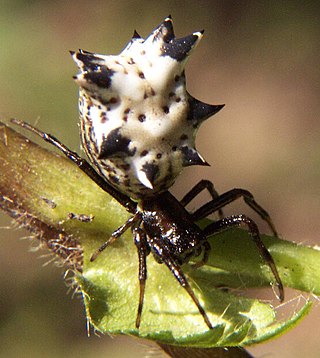
Micrathena gracilis is a spider in the family Araneidae (orb-weavers), commonly known as the spined micrathena or castleback orbweaver. This spider spins a moderately large and very tightly coiled web. The spiders themselves are small and can be found to be anywhere from 4.2 mm to 10.8 mm long. Its venom is harmless to humans. M. gracilis is unique in appearance due to its large spiky abdomen and black and white bodies. Certain spiders of this species can also display a yellow color on the sides of their bodies. These spiders can be seen most active during the end of the summer and beginning of fall. M. gracilis is diurnal and are rarely ever seen active at night.

Micrathena, known as spiny orbweavers, is a genus of orb-weaver spiders first described by Carl Jakob Sundevall in 1833. Micrathena contains more than a hundred species, most of them Neotropical woodland-dwelling species. The name is derived from the Greek "micro", meaning "small", and the goddess Athena.

Eurybia furcata, commonly called forked aster, is an herbaceous perennial in the family Asteraceae. It is native primarily to the Great Lakes region and the Ozark Mountains in the United States. It is uncommon throughout its range, and occurs in the states of Michigan and Wisconsin in the north, south through Nebraska, Illinois, Iowa, and Indiana, and into Missouri and Arkansas. The species is intolerant of shade and is typically found on rocky, north-facing slopes, especially those composed of limestone, dolomite, or sandstone. It can also be found in seeps on bluffs, in moist woods along streams, and occasionally in disturbed sites. It is included in the Center for Plant Conservation's National Collection of Endangered Plants.
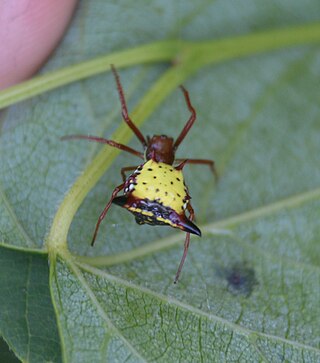
Micrathena sagittata, also known as the arrow-shaped micrathena, is a species of spider belonging to the family Araneidae. It is found in the eastern United States and throughout Central America.
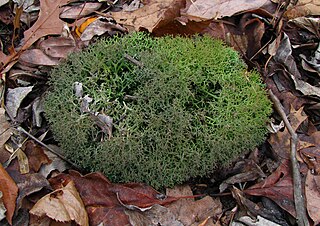
Cladonia furcata or the many-forked cup lichen is a species of cup lichen in the family Cladoniaceae. It has an intermediate to tolerant air pollution sensitivity. Extracts of this species have been shown to kill leukemia cells in vitro, and may have possible value in the treatment of cancer.
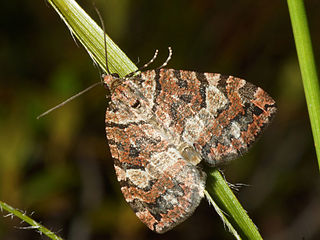
Hydriomena furcata, the July highflyer, is a moth of the family Geometridae. The species was first described by Carl Peter Thunberg in 1784. It is found in the Holarctic ecozone.

Porites furcata, commonly known as hump coral, thin finger coral or branched finger coral, is a species of stony coral in the genus Porites. It is found in the Caribbean Sea and western Atlantic Ocean.
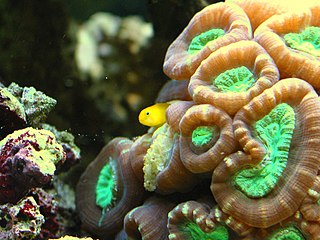
Caulastraea furcata, also known as the candy cane, trumpet, or bullseye coral, is a species of large stony coral in the family Merulinidae.
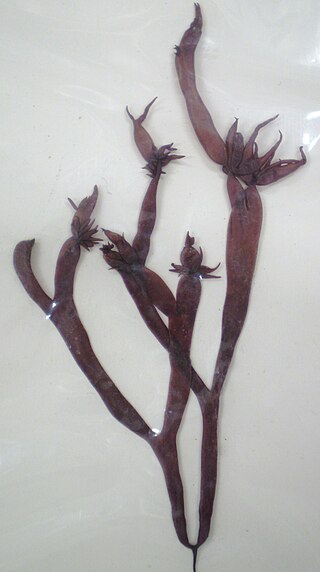
Gloiopeltis furcata, commonly known as glueweed, jelly moss and fukuro-funori (Japan), is a marine alga that is widely distributed in the North Pacific Ocean, along the shorelines of China, Taiwan, Korea, Japan, and the Pacific shores of Russia; and from the Aleutian Islands south to Baja California. G. furcata has long been utilized as a food source in Asia, where it is also used as a sizing material in silk and other textiles. G. furcata is also a raw material for textile binders. Studies show that extracts of G. furcata inhibit the growth of several human cancer cell lines, and can significantly lower blood glucose levels.

Artemisia furcata, the forked wormwood, is an Asian and North American species of plants in the sunflower family found in cold regions at high elevations or high latitudes. It is native to Canada, the United States, eastern Russia, Kazakhstan, and Japan.
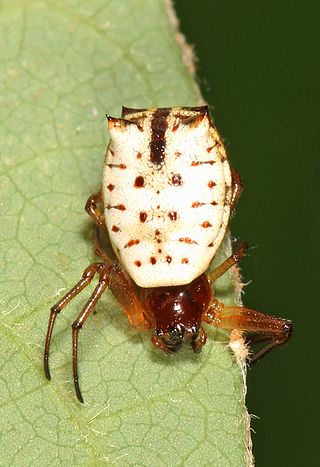
Micrathena mitrata, the white micrathena, is a species of orb weaver in the spider family Araneidae. It is found in a range from the United States to Brazil. The spider has a distinctive appearance with a shiny, black abdomen and spiky, yellowish-brown legs. Its body length ranges from 4 to 9 mm in females and 3 to 4 mm in males. The species is known for its elaborate web, which it uses to capture insects for food. Despite its fearsome appearance, Micrathena mitrata is not considered dangerous to humans and is generally regarded as a harmless spider.
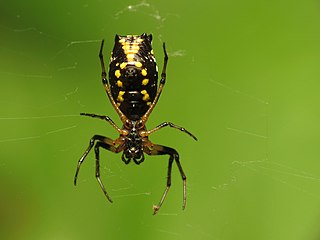
Micrathena funebris is a species of orb weaver in the spider family Araneidae. It is found in a range from the United States to Costa Rica.
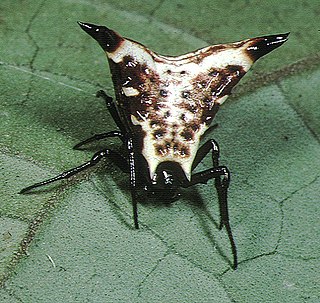
Micrathena lucasi is a spider in the orb-weaver spider family, Araneidae. The species belongs to genus Micrathena and was first named in 1864 by Eugen von Keyserling.
Micrathena lepidoptera a species of orb weaver in the family Araneidae. This species has been found in Costa Rica and Colombia and is endemic to Sierras Nevadas of northern Colombia. Not much is known about this species, including its diet, life cycle, and reproduction. A study by Ivan F. Magalhaes and Alberto J. Santos saw members of the Micrathena group genetically tested to better organize the Micrathena and Chaetacis phylogenetic trees. This paper includes four synapomorphies for this species. These include: wrinkled booklung covers, epigynum with a pair of anterior apodemes, small copulatory openings that are concealed beneath lateral plates, and terminal apophysis that is fused to the embolus. The females of this species are distinct by having three compound spines on the each side of the abdomen, with a thoracic depression and dimples in the carapace and blunt spines on either side of the spinnerets.
Micrathena yanomami is a species of orb-weaver spider described in 2011. Its distribution includes French Guiana, Brazil, and Peru. The species was first described by arachnologists Ivan Magalhães and Adalberto Santos.
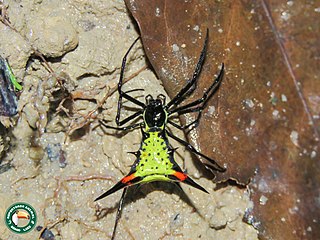
Micrathena schreibersi, also known by its common name Amazon thorn spider, is a species from the genus Micrathena.

Micrathena swainsoni is a species from the genus Micrathena.

Micrathena sanctispiritus is a species from the genus Micrathena.

















